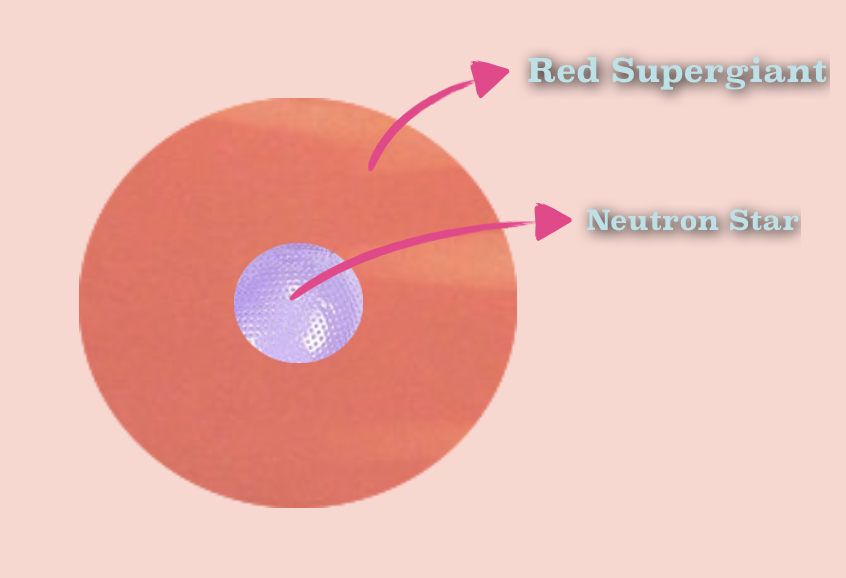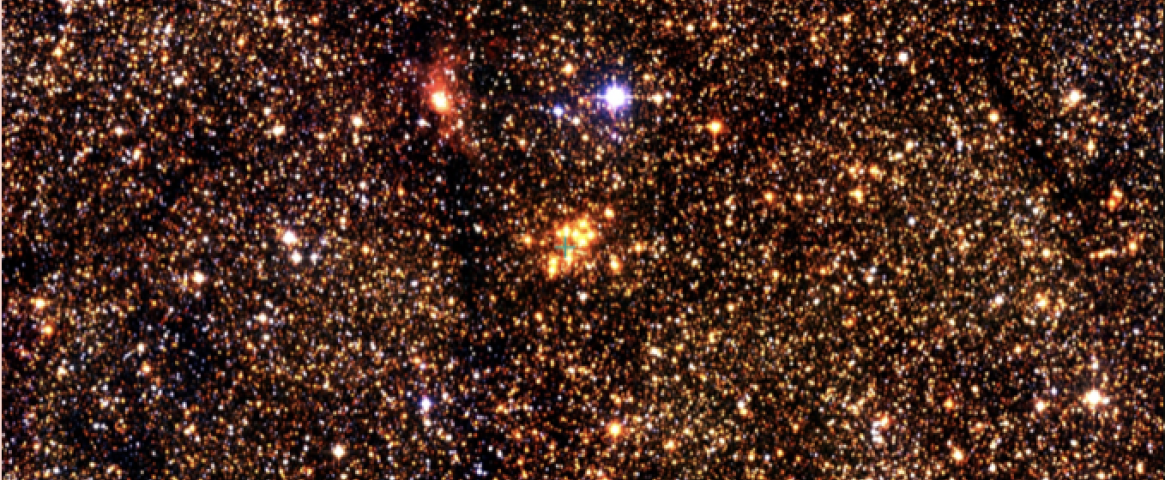By Briley Lewis
Lurking in our galaxy, there are dead stars in disguise. They may not be disguised for long, though — astronomers recently determined a new way to reveal their true identities using gravitational waves, ripples in the fabric of spacetime first detected in 2015.
These impostor stars are known as Thorne-Żytkow Objects (TŻOs). Through a telescope, a TŻO looks like an ordinary red supergiant star, but at its core lies a neutron star—the superdense remnant of a supernova. Scientists have predicted that many TŻOs exist in our galaxy, but so far none have been detected definitively. Finding one would allow new ways of testing astrophysicists’ understanding of stellar physics.
“TŻOs are notoriously difficult to identify, so having another method in our toolkit is always useful,” said Anna O’Grady, a graduate student in astronomy at Canada’s Dunlap Institute for Astronomy and Astrophysics. “It’s a significant step forward in identifying new ways to find TŻO candidates.”
TŻOs were theorized by gravitational physicist Kip Thorne and astrophysicist Anna Żytkow in 1977. The duo predicted that a neutron star could merge with a large, old star known as a red supergiant. This hybrid would be like “the corpse of a star wearing a living star’s body,” according to astronomy graduate student Lindsay DeMarchi of Northwestern University in Chicago. DeMarchi is the lead author on the recent study published in April in the Astrophysical Journal. “This supposedly dead star gets a second life by stealing the life force of this red supergiant.”

A fusion of two points in a star’s life, TŻOs can help researchers understand how more “mundane” stars evolve and how they die. One particular concern is the “squishiness” of a neutron star. This fundamental property is important for modeling many stellar processes, from supernova explosions to black hole formation.
These stars are tricky to identify precisely because of their nature as impostors. Light from a TŻO comes only from its outer layers, and its spectrum is not expected to be very different from that of a more conventional star. A few possible TŻOs have been identified—a star named HV 2112 is the current favorite of many stellar scientists, but its true nature remains uncertain.
Astrophysicists have previously proposed that a TŻO would emit gravitational waves as it forms, providing a way to distinguish it from an ordinary red supergiant. However, this “flash” of spacetime ripples would likely be too low in frequency to be detected with current technology, such as the Laser Interferometer Gravitational-Wave Observatory (LIGO), and too faint to be detectable by future space-based gravitational wave observatories.
DeMarchi and her collaborators instead predicted the gravitational waves that would be emitted continuously by a TŻO throughout its life. The source of these waves would be the neutron star, which is expected to be spinning extremely rapidly. If the neutron star had some imperfection on its surface, like a mountain, it could emit gravitational waves as it spins, thanks to the slight wobble induced by the imperfection. DeMarchi notes, though, that “for a neutron star, a mountain is literally the width of a human hair,” because of the object’s extremely strong gravity.

This continuous signal is very different from the brief “chirp” signals that LIGO receives from merging black holes. Continuous waves require researchers to analyze data covering a longer period of time. DeMarchi and collaborators calculate that a detection will require five days of data, given LIGO’s current setup.
To make that calculation, the team focused on RSGC1, a large star cluster. They believe that this cluster is highly likely to contain a detectable TŻO, since it’s nearby, and it contains many red supergiants and at least one neutron star. With five days of data, the researchers found that the TŻO gravitational wave signal could be as much as 10 times larger than LIGO’s background noise level in the best case scenario, enough to make a clear detection of one of these impostor stars.
“Using gravitational waves to find [TŻOs], or at least confirm their existence, is a really nice idea,” said astrophysicist Jan Eldridge of the University of Auckland, New Zealand. “TŻOs are strange objects, so we need innovating and imaginative ways to find them, as this paper presents.” Astrophysicist Sarah Gossan of the University of Toronto, Canada, said that she was “very excited to see this groundbreaking paper—hopefully it will be the first of many studies that consider the modelling and observation of TŻOs.”
Briley Lewis is a fourth-year graduate student and NSF Fellow at the University of California Los Angeles studying astronomy and astrophysics. She is a member of the Astrobites collaboration, contributing author for Massive Science, and former organizer for ComSciCon-Los Angeles. She also teaches writing at UCLA in her course for first year undergraduates, “Astrobiology in Science Journalism.” Follow her on Twitter @briles_34 or visit her website www.briley-lewis.com.
This story was produced as part of NASW's David Perlman Summer Mentoring Program, which was launched in 2020 by our Education Committee. Lewis was mentored by David Ehrenstein.
Main image: RSGC1, a cluster containing many red supergiants, as seen by the Two Micron All-Sky Survey (2MASS). New research suggests that Thorne-Żytkow Objects are likely to be found there. Credit: 2MASS/Aladin.




